THE Canyon – it is indeed Grand
In this segment (Part I), we focus on the Natural / Geological Story of Grand Canyon – a Story told by the Ancient People, as well as by today’s geology scientists. As we look over the South Rim, that Story traces what we see today back into deep time – back 1.7 billion years to the birth of the Vishnu basement rock the Colorado River has exposed at the bottom of the Canyon – back 4.6 billion years ago to the birth of Earth – back 13.7 billion years ago to the beginning of the Universe. It’s a story the Park Ranger said we can remember as the four “R”s – Rocks, (that were) Raised, and eRoded, by the River.
In Parts II & III, we focus on the Human Story of the Canyon. We can remember the human story using four different “R”s – Reflection, Respect, Responsibility, and Reverence
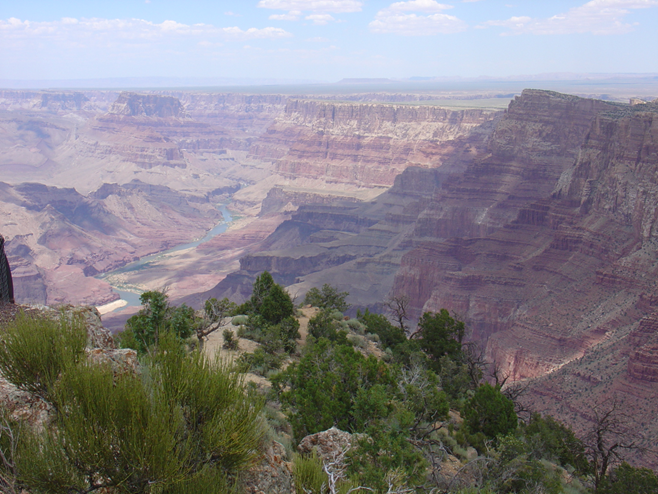
We just returned from several days at Grand Canyon National Park – my fourth visit actually.
On the first occasion over 20 years ago, I was the typical tourist according to Canyon folklore. I endured the long line at the Park entrance in the sweltering heat of a July afternoon, drove to the nearest parking area, jumped out of the car, ran up to the rim, looked over, said “Wow”, spent about 11 minutes taking a few pictures, then on to the visitors center/ gift shop before heading back to the car to hurry to the next “must see” item on the vacation list.
My next three visits were different from the first. I was able to see our Canyon in a different light – not just because the second visit was during the summer and third during the winter – but different because both the Canyon and I had changed.
Retirement also changes one’s perspective. Experiencing chest pains, and having a stent inserted into your right coronary artery seems to change one’s sense of time and one’s gratitude for each new day. Between visits, my awareness of our Canyon’s Story deepened, so too did my connection to this place and time.
Although I continue to take hundreds of pictures on each visit, in a feeble attempt to capture its essence, I am beginning to understand that a snapshot alone does little to capture our Canyon’s true essence. The Canyon is a time and place we can visit, but it is first and foremost an experience. The more we delve into the Story of our Canyon the more we become aware of its uniqueness on our planet – the more we appreciate its beauty – the more we commune with its spirit – the more precious it becomes – and the more we want to sustain it for future generations. I’m learning that the Canyon is ours to experience – but not to consume.
For some, it inspires. For some, it is a sacred site that cannot even be identified for fear of offending the spirit(s) of the Canyon.
“The whole Canyon and everything in it is sacred to us (Havasupai), all around, up and down,”
… Rex Tilousi, Havasupai Elder. [1]
For some, it energizes the soul. For some, it instills wonder. For some, the Canyon experience stirs human curiosity to ask “how did this come to be?” and as a result transforms people into explorers in search of answers.
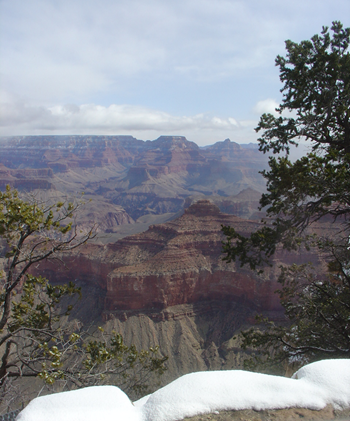 On a more recent visit to the Canyon, near the end of winter/beginning of spring, my partner, Gail, and I stayed for several days. This was enough time to hike along the South Rim trail as well as down into the Canyon using the South Kaibab Trail (one of several trails that allow you to go down this upside down mountain and look up.)
On a more recent visit to the Canyon, near the end of winter/beginning of spring, my partner, Gail, and I stayed for several days. This was enough time to hike along the South Rim trail as well as down into the Canyon using the South Kaibab Trail (one of several trails that allow you to go down this upside down mountain and look up.)
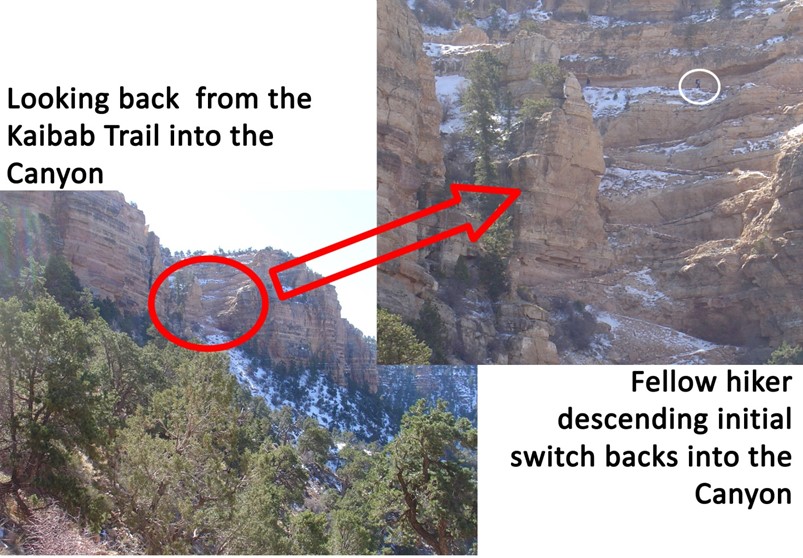
And we listened to what the Canyon had to say.
It spoke to us through the voice of Ranger Jack on a cold snowy March morning, as we walked along the South Rim trail with a small tour group. It spoke to us later that day in the Yavapai Geology Museum filled with murals depicting the geologic processes that formed the Canyon. It spoke to us the next day as we took a short hike into the Canyon via the Kaibab Trail.
It spoke to us silently one afternoon as we walked the “Trail of Time” along the South Rim, a recent educational feature added between Yavapia Point to the east and Maricopa Point just west of the Village.
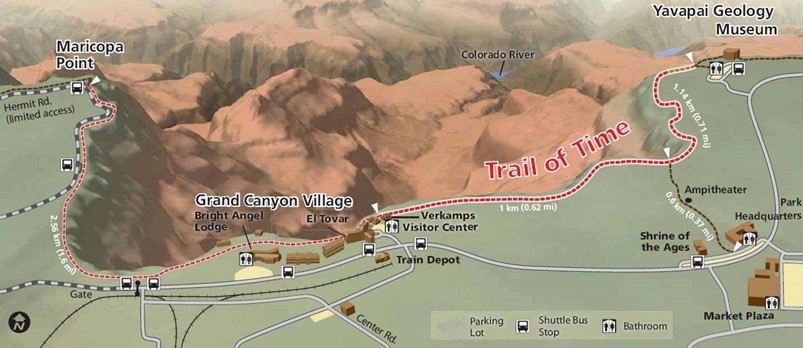
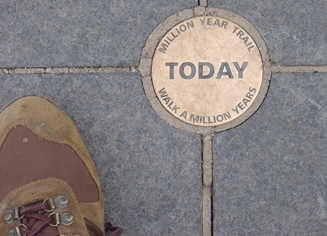 At Yavapai Point, the “Trail of Time” begins with a circular bronze plaque embedded in the walkway that reads simply “Today.”
At Yavapai Point, the “Trail of Time” begins with a circular bronze plaque embedded in the walkway that reads simply “Today.”
Just one giant step (1 meter) to the west, you find another circular marker with the number “1 Year ago.” Then another big step to “2 years ago.”
And so the Story of the Canyon begins.
As we and several other park visitors stand shivering at the start of the Trail, on a snowy March morning, Park Ranger Jack begins his version of the Canyon Story. We learn that information about the deep history of the Canyon continues to emerge. The Park Service continues to update its brochures, visitor guides and Ranger talks in an effort to keep up with the revised chapters of the Canyon’s Story.
Just 7 years ago, Wayne Ranney published a compilation of Canyon Stories, (as told in the language of the geologists,) that indicates scientists all agree that “The Grand Canyon was carved by the Colorado River.” But beyond that simple statement there is still ongoing debate.
Ranney goes on to say, “To date, geologists have been unable to determine the canyon’s precise age and what specific processes were at work in carving it.” The issue is that there are too many viable processes and sequences of events that could explain what we see today. Until geologists narrow down these options (or the combination of options) the amount of time the river has been carving the Canyon (its age) can range from 6 million years (the most probably scenario) to as long as 70-80 million years. In any case, the carving of the Canyon is a relatively recent event in the Earth’s geologic life of 4.5 billion years.
After 50 more steps along the “Trail of Time”, the time scale changes and each step is used to represent 10 years, then 100 years.
Between 100 and 200 years ago (actually in 1858), John Strong Newberry, a physician and geologist stood on the South Rim, looked down into the Canyon and later wrote “…the Colorado Plateau is to the geologist a paradise… the most splendid exposure of stratified rocks that there is in the world.”[2]
Eleven years later, in 1869, John Wesley Powell would observe the Canyon from within as his party negotiated the treacherous rapids of the Colorado River that carved the Canyon. Powell looked up at the Canyon and pondered “how did this come to be?”
And the human quest to “understand” the Canyon in an emerging language of science began at that point.
After Newberry and Powell, hundreds if not thousands of curious physical scientists (e.g. geologists, archeologist, paleontologists, etc.) have learned to listen to what the Canyon has to say. The people of science continue to sort through the ancient evidence and latest theories on how the Canyon came to be. As a result of this ongoing collective effort, the Canyon’s Story continues to unfold. The latest versions of the Story are made available in various formats at the Grand Canyon National Park visitor’s centers, museums, theaters, book stores, and Park sanctioned tours and Ranger talks.
As we continue our walk along the “Trail of Time” the bronze markers now switch to thousand year increments.
One thousand years ago ancestral Puebloans farmed the bottom of the Canyon and stored their food in caves carved into the sandstone walls high above the river.
We continue along the Trail and back in time. We reflect on the Ancient Peoples and their Story of the Canyon.[3]
Hualapai Legend of the Canyon. The Hualapais say that it was one of their cultural heroes, Pack-i-tha-a-wi, who made the Grand Canyon. There had been a big flood, and the earth was covered with water. No one could stir but Pack-i-tha-a-wi, and he went forth carrying a big knife he had prepared of flint, and a large, heavy, wooden club. He struck the knife deep into the water-covered ground and then smote it deeper and deeper with his club. He moved it back and forth as he struck it further into the earth, until the canyon was formed through which all the water rushed out into the Sea of the Sunset. Then, as the sun shone, the ground became hard and solid, as we find it to-day. Published by George Wharton James in 1912.
http://grand-canyon-vacation-information.com/hualapai-indian-legend.html
The “10,000 years ago” marker reminds us that nomadic hunters (Paleo-Indian) lived here after the last ice age and hunted the megafauna – these early people may have even influenced the extinction of the mysterious creations such as the Shasta Sloth, Wooly Mammoth, etc.
We pass by the “100,000 years ago” marker and soon arrive at “1 million years ago” to find an artfully crafted rock sculpture – a portrait of the Canyon’s deep time Story congratulating us that we had “just walked a million years.”
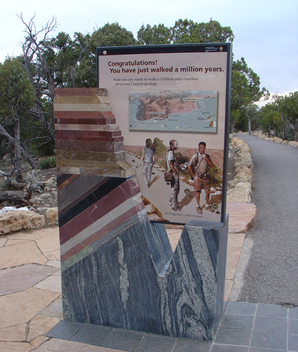 At the top of the sculpture we see horizontal layers of colorful sedimentary rock, then exposed layers of tilted rock layers all atop a huge marbled base notched with a “V” – the only element missing in this visual model of the Canyon is a small rivulet of sediment laden water flowing along the bottom of the “V.” This sculpture represents the remarkable geological record of Earth history that is exposed and on display at Grand Canyon – purportedly like nowhere else on the planet.
At the top of the sculpture we see horizontal layers of colorful sedimentary rock, then exposed layers of tilted rock layers all atop a huge marbled base notched with a “V” – the only element missing in this visual model of the Canyon is a small rivulet of sediment laden water flowing along the bottom of the “V.” This sculpture represents the remarkable geological record of Earth history that is exposed and on display at Grand Canyon – purportedly like nowhere else on the planet.
From the South Rim, the canyon walls plunge downward about 5,000 feet (1,500 m) to the Colorado river. Although extensive, the strata of Grand Canyon do not present a continuous record of Earth’s history. Some rock layers eroded away before newer layers were deposited on top. The gaps in time are called unconformities. Millions of years of time are missing along with their geologic stories.
A detailed list of the exposed layers down to Vishnu basement rocks are listed below:
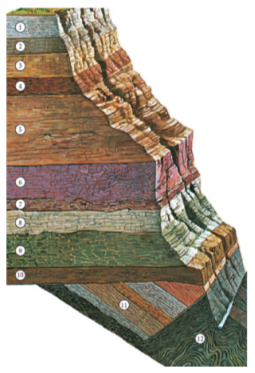
| # | Layer Name |
Layer Time Frame |
| 1 | Kaibab Formation |
270 mya |
| 2 | Toroweap Formation |
273 mya |
| 3 | Coconino Sandstone |
275 mya |
| 4 | Hermit Formation |
280 mya |
| 5 | Supai Group |
315–285 mya |
| 6 | Redwall Limestone |
340 mya |
| 7 | Temple Butte Formation |
385 mya |
| 8 | Muav Limestone |
505 mya |
| 9 | Bright Angel Shale |
515 mya |
| 10 | Tapeats Sandstone |
525 mya |
| 11 | Grand Canyon Supergroup |
1,250–650 mya |
| Unconformity | ||
| 12 | Vishnu Schist Basement Rocks |
1,840–1,680 mya |
Beyond this sculpture/trail marker, the time scale of the “Trail of Time” changes again and each step becomes 1 million years as the Rim Trail meanders westerly another 3 miles to Maricopa Point – 4,500 strides (4.5 km) – back 4.5 billion years ago when the Earth first took its present form.
But as we take the first 6 steps – just back 6 million years, geologist have determined the Grand Canyon was starting to be carved by Colorado River – a relatively recent event in geologic time. Were we alive back then, we would have observed that this large expanse of an ancient sea bed called the Colorado Plateau had been uplifted some 7000 to 8000 feet above sea level by the relentless motion of the tectonic continental plates 70 million years earlier. We would see the Rocky Mountains to the east, the source of the river known as the Colorado, towering still more than a mile above us. This two-mile high source of cascading water became the legendary Hualapai Warrior’s knife that cut into the landscape allowing the land to be sweep into the Gulf of California/Pacific Ocean. Over a period of several million years, using the process of erosion, the river persistently carved this grand canyon – so appropriately named. [4] Layer after layer of sedimentary rock, each older than the one above it, down to the Vishnu basement rock is now exposed by the river as it continues to flow – now more than 5000 feet below the South Rim.
The “Trail of Time” takes us further back in time. Directly under the Kaibab sediment layer we are walking on there are 10 more discrete rock layers [5] that were deposited during the past 525 million years. As we travel back in time, we pass specimens of these rock layers placed on granite pedestals.
But the best is yet to come.
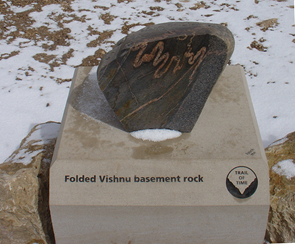 As we pass the “1700 Million Years Ago” marker on the “Trail of Time”, we find a specimen of the Vishnu basement rock that has been pulled from the very bottom of Canyon. The marker indicates this rock was born (changed from molten matter that comprises the earth’s mantle into its present solid form we know as Earth’s crust) between 1.6 and 1.8 billion years ago. It’s the rock the Colorado River is currently grinding over today as it passes through the Canyon on its way to Lake Mead, then through the hydroelectric turbines of the Hoover Dam and on to the Pacific Ocean via the Gulf of California.
As we pass the “1700 Million Years Ago” marker on the “Trail of Time”, we find a specimen of the Vishnu basement rock that has been pulled from the very bottom of Canyon. The marker indicates this rock was born (changed from molten matter that comprises the earth’s mantle into its present solid form we know as Earth’s crust) between 1.6 and 1.8 billion years ago. It’s the rock the Colorado River is currently grinding over today as it passes through the Canyon on its way to Lake Mead, then through the hydroelectric turbines of the Hoover Dam and on to the Pacific Ocean via the Gulf of California.
The granite pedestal holding the Vishnu Schist rock [6] invites the passerby to “Touch Me.” I couldn’t resist. The polished surface displays the crystalline structure of the metamorphic rock. As my hand passed over this 1.7 billion year old piece of our planet, I knew from the Story of the Universe that this too is star stuff that reaches back into deep time.[7] I knew that the elemental atoms that make up the Vishnu Schist are actually much much older than our solar system – created when our Grandmother Star, probably a super nova, exploded giving birth to all the elements in the periodic table that are heavier than iron. We find traces of these relatively rare elements in the Canyon (and across the planet.) As we better understand the spectrum of light from other galaxies, we have reason to believe these same elements exist throughout the Universe.
Ironically, the rare elements found in the Canyon that are more complex than iron (e.g. Copper, Uranium)[8], that enlighten our understanding of our deep ancestry, also serve as bait that attracts uncaring capitalists who are ever eager to tear into the Canyon rock and extract these minerals for financial gain – thereby placing the Canyon under constant siege. As a result the Canyon is both enlightening to the commons’ consciousness and also enticing to unscrupulous extraction capitalists unable to appreciate her natural beauty.
So as if the Story of the Grand Canyon (told in the language of science) is not amazing enough, thanks to the ever evolving human consciousness and our mastery of collective learning (i.e. our human ability to build upon the knowledge of previous generations) we can now weave the Canyon’s 6 million year Story into the very fabric of the Earth’s 4.5 billion year Story and the Earth’s Story into the 13.7 billion year Universe Story. How grand is that?
Our Canyon is truly one of the great sources of wonder in the world and rightfully designated by UNESCO as a World Heritage Site.[9]
So that’s Part I of our story about “How did the Canyon come to be?”
Part II of “How did the Canyon come to be?” will focus on the Human Story of the Canyon. To help remember the human story we will use introduce four different “R”s – Reflection, Respect, Responsibility, and Reverence
Part III of the story will discuss privatization – “How our ‘for-profit’ social system tries to kill the Canyon.“
Originally written 24 Mar 2012. Updated 4 Dec 2017.
[1] A similar sentiment is documented in the DVD. “The Light of Reverence.”
[2] “Carving Grand Canyon: Evidence, Theories, and Mystery”, by Wayne Ranney, Grand Canyon Association, 2005.
[3] Ancient people knew the Canyon was special, even sacred, and also pondered “how did it get to be.” Using concepts and mental images available to them at the time, they described the canyon as the work of a Great Warrior who thrust his knife deep into earth and moved it side to side to form the canyon walls.
[4] Today over 800 cubic miles of the earth has been removed from the Canyon. 800 cubic miles is the size of a cube that extends 9 miles to the north, 9 miles to the east and 9 miles high. 800 cubic miles is the size of a tube 2 miles in diameter and 277 miles long.
[5] Under the Kaibab Formation (Fm)(270 mya) is: Toroweap Formation (273 mya), Coconino Sandstone (275 mya), Hermit Formation (280 mya), Supai Group (315 mya), Surprise Canyon Fm (320 mya), Redwall Limestone (340 mya), Temple Butte Fm (385 mya), Muav Limestone (505 mya), Bright Angel Shale (515 mya), Tapeats Sandstone(525 mya)
[6] The 1.7 billion year old Vishnu Schist is comprised of quartz-mica schist, pelitic schist, and meta-arenites.
[7] Translating the language of geology to the language of chemistry, quartz is made up of 14Si and 8O. Micas typically include 1H, 8O, 9F, 11Na, 12Mg, 13Al, 14Si, 19K, 20Ca, 26Fe and less frequently 3Li, 22Ti, 24Cr, 25Mn, 37Rb, 56Ba, 55Cs. Then translating the language of chemistry to the language of the physics and cosmology, we see that the although the Vishnu Schist was born (metamorphosed) 1.7 billion years ago, it is made of older star stuff – created through stellar nucleosynthesis by stars much bigger than our sun – stuff created before our Sun was born – star stuff created more than 4.5 billion years ago. The Universe Story also tells us that all the elements contained within the Vishnu Schist that have atomic numbers greater than 26Fe are the children of supernova nucleosynthesis – produced at the dramatic end of life of a supernova class star, when it explodes and creates the intense conditions required to fuse nuclei together that are more complex than iron 26Fe. Our gravitational center we call Sun gathered together a family of primordial hydrogen and helium as well as material from nearby spent supernova. From this star stuff, Earth and the other planets were formed – from which all of life was formed. As we compare the elemental materials contained in the Vishnu Schist, we find a striking similarity to the list of the 26 elements found in the human being (H, B, C, N, O, F, Na, Mg, Si, P, S, Cl, K, Ca, V, Cr, Mn, Fe, Co, Ni, Cu, Zn, Se, Mo, Sn, I). For example, using the basic materials contained in the human, one could make quartz and at least 10 different types of the complex mineral mica.
[8] Copper, 29Cu , was mined from the Horseshoe Mesa between 1890 and 1907. The Grandview Trail now used by thousands of hikers into the Canyon was built by the Last Chance copper miners to haul the rich ore up 3000 feet to the South Rim. Other extraction industries, including uranium, oil & gas are constantly trying to gain access to Canyon land, even though it has the prestigious U.S. National Park and the UNESCO World Heritage Site status.
[9] United Nations United Nations Educational, Scientific and Cultural Organization (UNESCO) seeks to encourage the identification, protection and preservation of cultural and natural heritage around the world considered to be of outstanding value to humanity. World Heritage Emblem. The World Heritage emblem represents the interdependence of the world’s natural and cultural diversity…. It identifies properties protected by the World Heritage Convention…and represents the universal values for which the Convention stands…the central square symbolizes the results of human skill and inspiration, the circle celebrates the gifts of nature….round, like the world a symbol of global protection for the heritage of all humankind.
No Comments